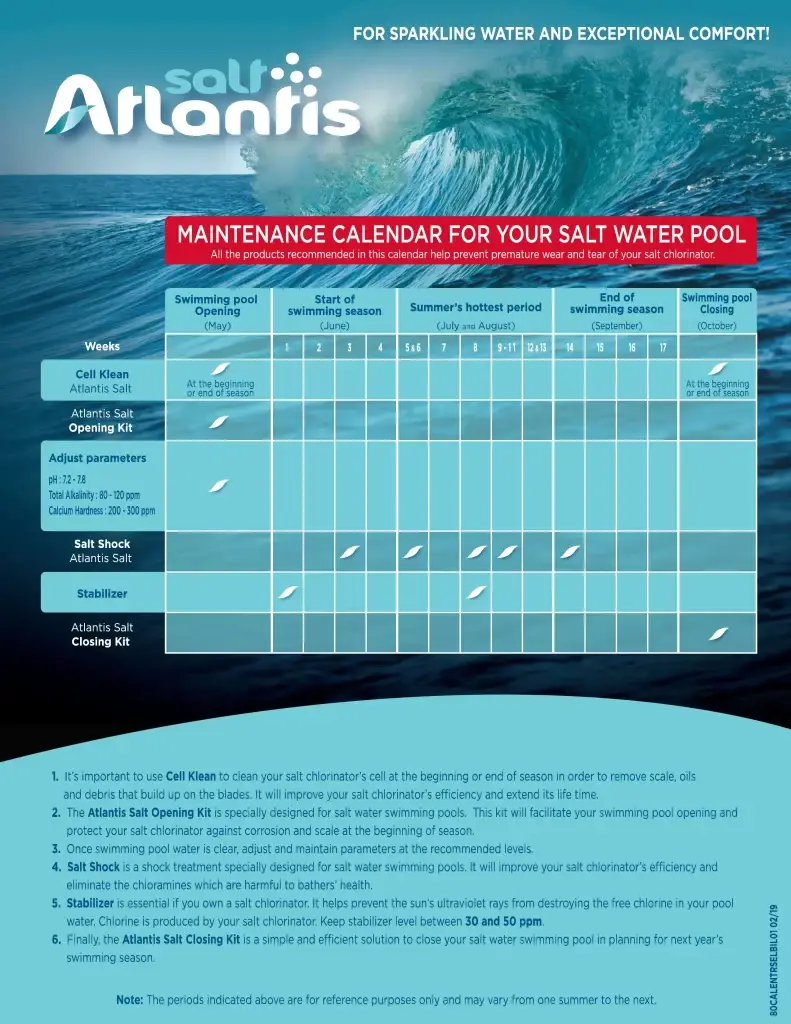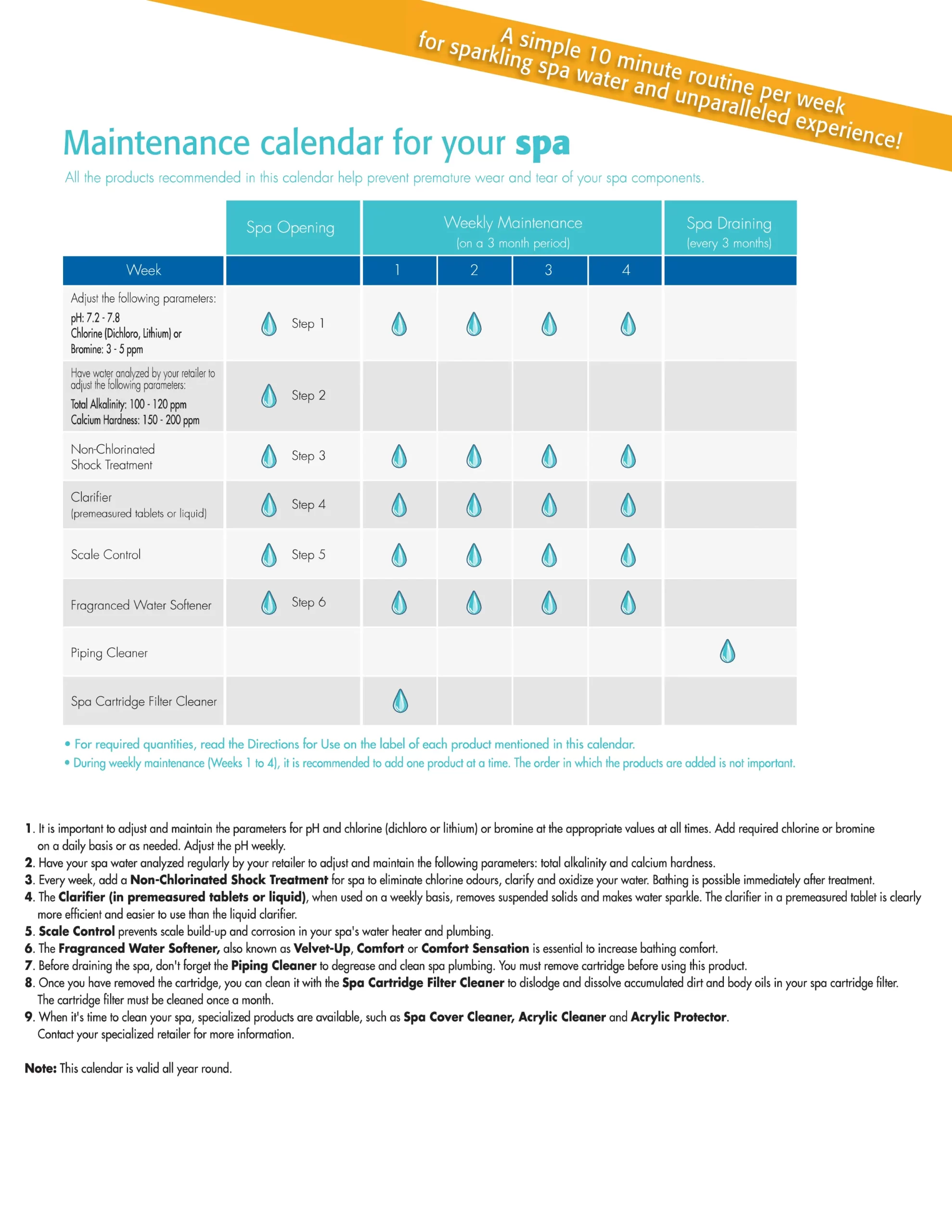FREQUENTLY ASKED QUESTIONS (FAQ)
Salt pool maintenance
Introduction
RBF presents a simple and effective maintenance schedule for your salt water pool, to keep your bathing water clear and limpid all summer long.
Understand how a salt pool works to ensure proper maintenance
Saltwater pool owners are often sold the idea that there is no maintenance required once they purchase a salt system. This is not true!
A salt system replaces just one product: chlorine.
A salt system typically consists of 3 parts: a cell, a control box, and a water flow sensor. The key component is the cell, as it converts saltwater into chlorine through electrolysis. People with a salt system might think there is no chlorine in the pool, but there is. A pool without chlorine could not be disinfected. Therefore, the salt system’s cell is essentially a compact chlorine factory. Thanks to the dial on the control box, you can set how long, per day, you want the cell to produce chlorine. Each control box is equipped with a production dial. In most cases, this dial allows for the management of chlorine production in percentage (%).
Unlike its competitors, the E25/E35 operates on a percentage of power instead of a production time percentage. So, if you set the dial to 40%, it means the cell will produce chlorine at 40% of its maximum capacity throughout the day. Additionally, the polarity reverses every 4 hours.
level of chlorine in the salt pool.
The cell has a lifespan measured in the amount of chlorine produced. For example, consider a cell with a lifespan (chlorine production) of 113 kg (250 lb) of chlorine. If you unnecessarily set the machine to 100%, it will produce 113 kg of chlorine in 2 years, which is very harmful to your pool equipment. Once the cell has produced 113 kg of chlorine, it will need to be replaced, which is very costly. You know you have programmed the system correctly when the chlorine level is maintained at the appropriate value, between 1 and 3 ppm. The schedule explains the maintenance to be performed during the summer to optimize the lifespan of the cell at a lower cost. This schedule will allow you to decrease the production percentage of the system to extend the cell’s lifespan. It will also help maintain the water parameters at the appropriate values.
- Total Alkalinity: 80 – 120 ppm
- Hardness (Calcium): 200 – 300 ppm
- Stabilizer: 30 – 50 ppm
- pH: 7.2 – 7.8
- Chlorine: 1 – 3 ppm
One of the most important things to remember for a saltwater pool is cleaning the cell.
Maintenance schedule
How to read and understand the salt pool maintenance chart
The maintenance chart shows how to prevent premature wear and tear on the salt system and keep the water clear all summer long. To find out how much to use, refer to the instructions on the labels of each of the products listed in the schedule. For weekly maintenance (Weeks 1 to 17), we recommend waiting 30 minutes between each product before adding the next. The order of the products is not important.
- It's important to use Cell Klean to clean the salt chlorinator cell at the beginning or end of the season, to remove limescale, oils and organic debris that accumulate on the plates. It will improve the efficiency and life of the salt chlorinator.
- The Atlantis Salt Opening Kit, specially designed for salt pools, makes opening the pool easier and protects the salt chlorinator from corrosion and scale formation at the start of the season.
- Once the pool water is clear, adjust and maintain the parameters at the appropriate values.
- Salt Shock Treatment, specially designed for salt pools, should be used regularly to counteract the lack of chlorine that the pool can suffer during long periods of heat and heavy use.
- Don't forget the Stabilizer. It prevents the destruction of chlorine caused by the sun's ultraviolet rays. Chlorine is produced by the salt chlorinator. Adding Stabilizer at the start of the season can save up to 40% chlorine over the summer. Stabilizer levels should be kept between 30 and 50 ppm.
- Finally, at the end of the season, the Atlantis Salt Closing Kit is a simple and effective solution for closing your salt pool in preparation for the next swimming season.
Spa maintenance
Introduction
- Total Alkalinity: 100 – 120 ppm
- Calcium Hardness: 150 – 200 ppm
- pH: 7.2 – 7.8
- Chlorine (dichlor) or Bromine: 3 – 5 ppm
Maintenance schedule
How to read and understand the spa maintenance chart
The maintenance chart shows you how to keep your spa water sparkling. All suggested products help prevent premature wear and tear on your spa’s components. To find out how much to use, consult the instructions on the labels of each of the products listed in the schedule. For weekly maintenance (Weeks 1 to 4), we recommend using one product at a time. The order of the products is not important.
- Start by adjusting and maintaining the pH and chlorine (dichloro) or bromine parameters at the appropriate values at all times. Add your required chlorine (dichloro) or bromine on a daily basis or as needed. pH should be adjusted weekly.
- Be sure to have your spa water tested by your dealer to adjust and maintain the following parameters: total alkalinity and calcium hardness.
- Chlorine-free Spa Shock Treatment should be used weekly to eliminate chlorine odours, clarify and oxidize the water. Swimming is possible immediately after treatment.
- Using Clarifiant on a weekly basis (pre-measured tablets suggested) removes suspended particles and restores the water's brilliance. Pre-measured tablets are far more effective and easier to use than liquid clarifiers.
- The addition of Anti-scale prevents scale formation and corrosion in your water heater and spa piping.
- It's a good idea to use a flavored softener, often known as Velours Plus, Confort or Comfort Sensation, to increase bathing comfort.
- Before draining the spa, don't forget to use Pipe Cleaner to degrease and clean the spa pipework. The cartridge must be removed before use.
- Once you've removed the cartridge, take the opportunity to clean it with Spa Cartridge Filter Cleaner to dislodge and dissolve grease and body oils accumulated in your filter. The cartridge filter should be cleaned once a month.
- When it comes to cleaning your spa, specialized products are available, such as Cover Cleaner, Acrylic Cleaner and Acrylic Protector. Ask your specialized dealer for details.
Note: This calendar is valid for all months of the year.


